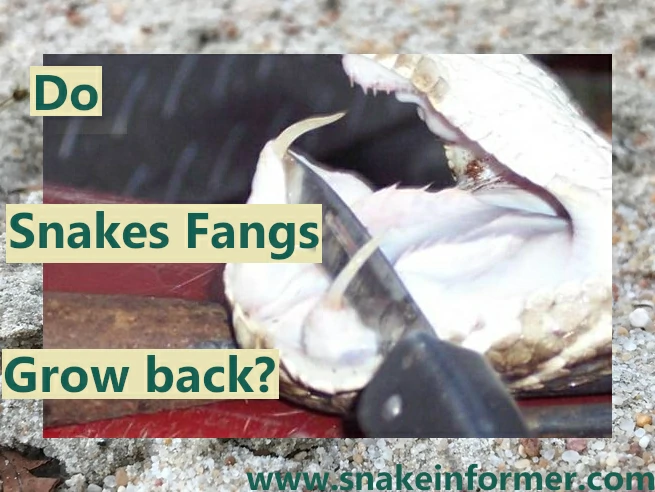The vast majority of snakes have thin sharp teeth, highly adapted for catching and holding prey. Venomous snakes like rattlesnakes and copperheads, have fangs in addition to teeth.
They use these fangs to deliver venom when they bite to subdue prey or for defense.
Snakes can replace their fangs, and other teeth throughout their life. Behind each functional fang, there are one or more replacement fangs at different stages of growth.
If a fang breaks off, the replacement fang can take over within a few weeks.
Snakes Regularly Shed and Replace Their Fangs
Snakes shed, and replace their teeth (including fangs) many times throughout their lives.
Unlike humans and most mammals, who only regrow our teeth once, snakes continually replace their teeth.
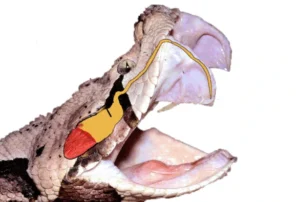
This ensures they always have a functional set of teeth (and fangs) for feeding and defense.
Inside a snake’s jaw, there are four to six fangs, in different stages of development, lined up behind each functional fang.
This means that at any given time, a snake has backup fangs, waiting to come into use.
Why Do Snakes Replace Their Fangs?
There are several reasons why snakes would replace their fangs.
They could get damaged, worn out, or even replaced as part of a regular schedule.
1. They Get Damaged During Feeding
One of the most common reasons snakes replace their fangs, is when they get damaged during feeding.
Snakes do not chew their food, they swallow their prey whole – relying on their very powerful digestive enzymes to break it down over time.
When a snake bites into prey, a fang can easily crack, or even break and need to be replaced.
2. They Become Worn Out From Regular Use
Even without breaking, snake fangs experience a lot of stress from regular use.
Snakes’ teeth and fans often face a lot of friction as they are used.
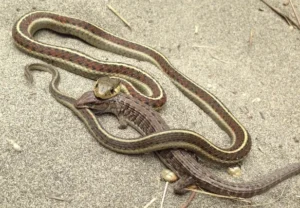
This causes them to become worn down over time, and become less effective at injecting venom.
3. Regular Shedding and Replacement
Snakes replace their fangs and other teeth, even if they are not damaged.
They replace their teeth and fangs regularly, like planned maintenance, to keep them functioning at their best.
Think of it like a conveyor belt, where teeth and fangs are replaced based on a certain schedule.
How Do Snakes Regrow Their Fangs?
When a snake’s fang gets closer to the end of its use, the replacement fang starts to shift forward, already connected to the venom duct.
In some species, this movement happens as a slow rotation, where the replacement fang pivots from its hidden position into an upright and usable position.
In others, it may slide horizontally or vertically into place, guided by the jaw tissues and ligaments.
As the new fang moves into place, it begins to push out the old fang.
Often the old fang is physically pushed out by the pressure of the incoming fang.
Sometimes, the old fang may gradually loosen and fall out on its own.
Shed fangs are sometimes found stuck in prey when a snake strikes.
This whole process happens without a snake’s ability to strike prey or defend itself.
Can a Snake Live With Broken Fangs?
In most cases, a broken fang is not a problem for snakes.
The broken fang will be quickly replaced, and the snake can continue living normally.
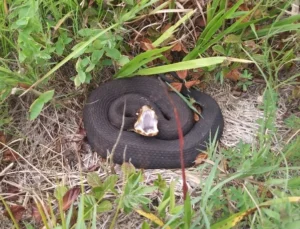
However, sometimes a snake’s fang can break off, in a way that leaves an injury in the gum or jaw.
This can happen when a snake accidentally strikes a hard surface.
The injury can lead to infection or swelling, making it hard for the snake to hunt, or defend itself.
That said, this is quite rare. In most cases, a snake’s broken fang will be quickly replaced without any complications.
Not All Snakes Have Fangs
While most snakes have teeth, not snakes have fangs.
The purpose of fangs is to inject venom, often into prey, so only venomous snakes have them.
Non-venomous snakes typically rely on muscular strength to coil around and suffocate their prey.
Their teeth then grip and swallow the prey whole.
A few snake species that do not have fangs include:
1. Rat Snakes (Pantherophis obsoleta)
Rat snakes are very quick and rely on their agility to ambush, rodents, birds, and other small animals.
When the prey is captured, they use their backward curving teeth to hold on tightly.
They then wrap their bodies around the animals and tighten just enough to suffocate it, or stop movement.
Once the prey is immobilized, they swallow it whole.
2. Corn Snakes (Pantherophis guttatus)
Like rat snakes, corn snakes are highly effective predators.
They mainly eat rodents, but will also hunt birds, frogs, lizards, or other small animals when they get the chance.
When a corn snake finds a prey item, it quickly strikes and uses its teeth to hold on to the animal.
It then wraps several coils around its body and tightens to stop breathing.
Once the prey stops moving, the snake loosens its coils and swallows the prey whole.
3. All Boas and Pythons
All boas, pythons, and anacondas are not venomous and lack fangs.
Like many other snakes, they coil around their prey and suffocate it, before swallowing it whole.
4. African Egg-Eating Snakes (Dasypeltis)
African egg eaters are unique in that, they have no visible teeth at all!
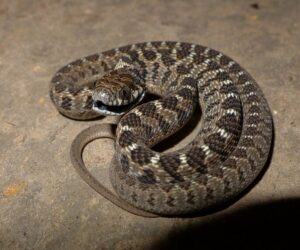
These snakes exclusively eat birds’ eggs and do not need teeth (or fangs)
When they swallow an egg, they crush the shell with their powerful neck muscles. They then swallow the contents and regurgitate the crushed shell.
Conclusion
Snakes regularly regrow their fangs several times throughout their lives.
Unlike most mammals who only replace their teeth once, snakes can continually replace their teeth and fangs when needed.
That said, it’s important to note that not all snakes have fangs.
The purpose of fangs is to deliver venom, so only venomous snakes will have them.
Featured image credit: Rynrdnr, CC BY-SA 3.0,via Wikimedia Commons
Sources:
Itay Tesler, Jaim Sivan, Abraham Allan Degen, Michael Kam, Replacement of fangs in a free-ranging desert viperid, Cerastes vipera, Zoology, Volume 152, 2022, 26013, ISSN 0944-2006, https://doi.org/10.1016/j.zool.2022.126013.
Segall M, Houssin C, Delapré A, Cornette R, Herrel A, Milgram J, Shahar R, Dumont M. Armed to the teeth: The underestimated diversity in tooth shape in snakes and its relation to feeding behavior and diet. Ecol Evol. 2023 Apr 13;13(4):e10011. doi: 10.1002/ece3.10011.
Vonk, F., Admiraal, J., Jackson, K. et al. Evolutionary origin and development of snake fangs. Nature 454, 630–633 (2008). https://doi.org/10.1038/nature07178
Hi, my name is Ezra Mushala, i have been interested animals all my life. I am the main author and editor here at snakeinformer.com.

